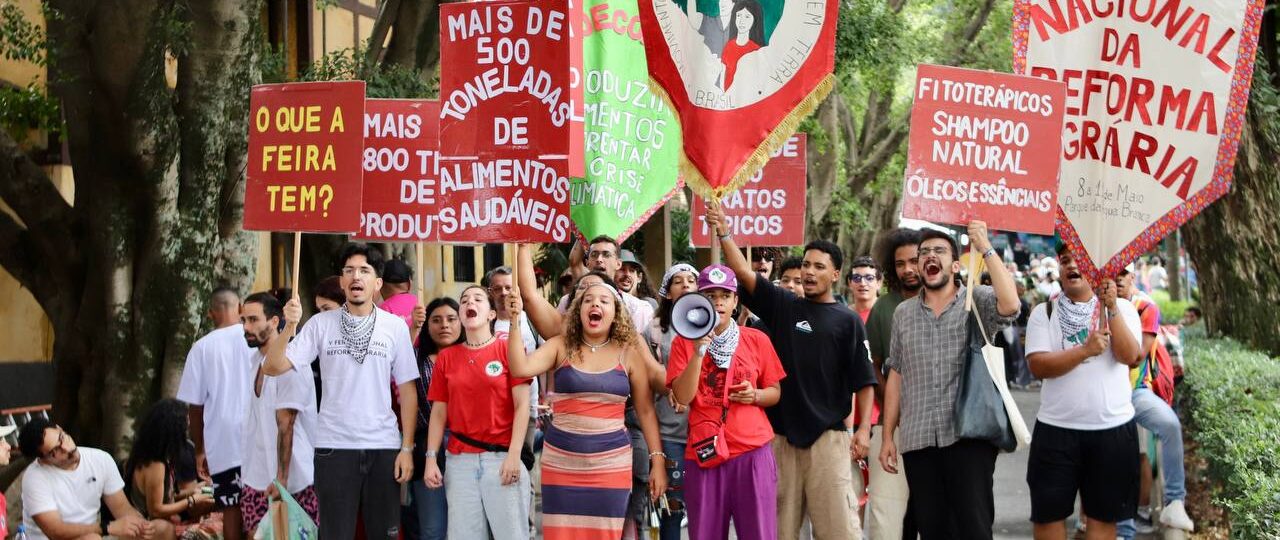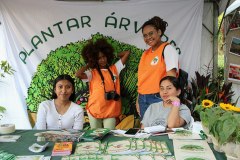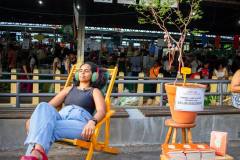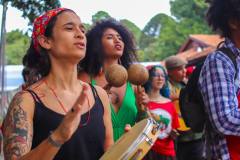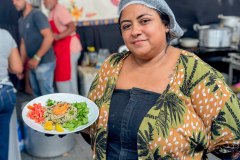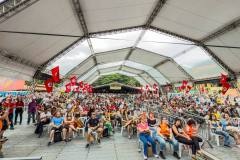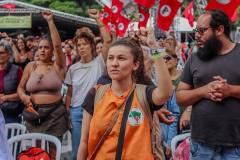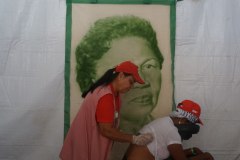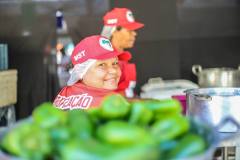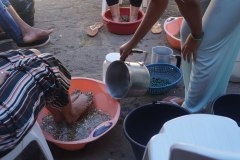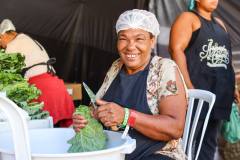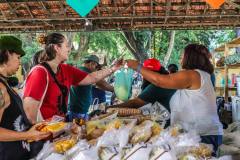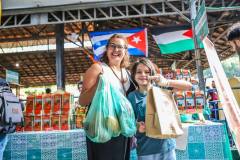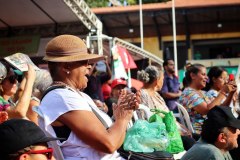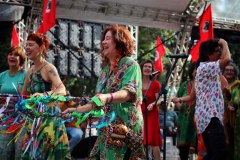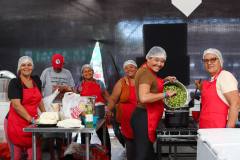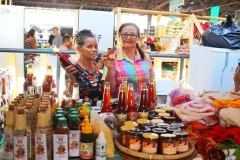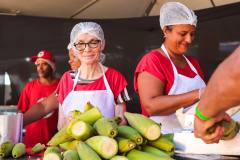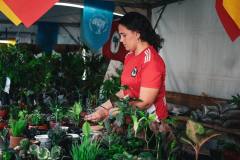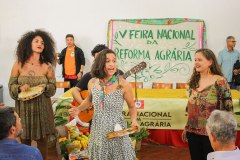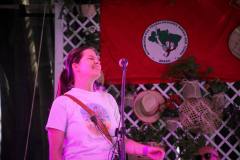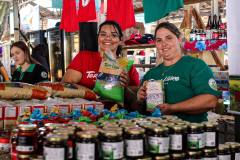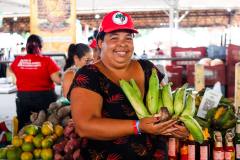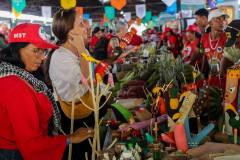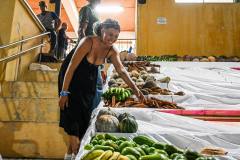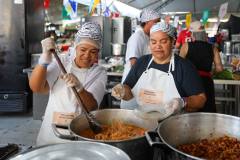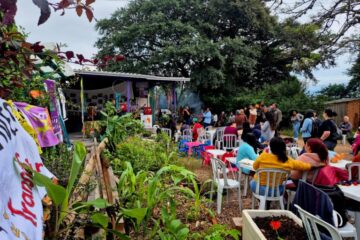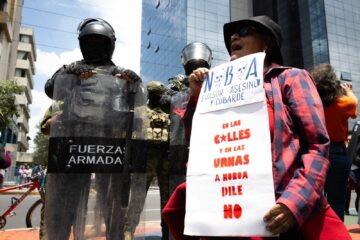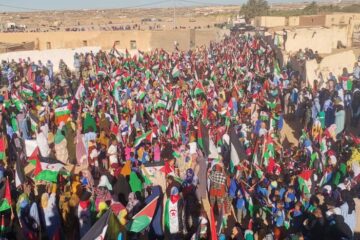The 5th National Agrarian Reform Fair brought together more than 2,000 farmers from the settlements and encampments 1In the Brazilian context, MST encampments are usually idle plots of land in rural areas that are not fulfilling the social function of the land, which are occupied by landless families as a tactic to demand the enforcement of agrarian reform. Settlements are areas that have already undergone agrarian reform processes, where families have the legal security to remain and produce. of the Landless Workers’ Movement (MST) between May 8th and 11th, 2025. It featured 580 tons of food, a great diversity of 1,920 types of products, local cuisine from 23 regions, art, culture, and discussion panels that synthesized and expressed, in practice, the Popular Agrarian Reform agenda and its centrality in the Brazilian context. At Capire,we are featuring pictures of the participation of women farmers at the fair, produced by the MST Communications Team, and excerpts from an article by Nívia Regina, an MST leader and member of the movement’s Internationalist Brigade to Cuba. Her full article is available in Portuguese on the MST website.
The National Fair is a great wheel of agroecology
Within the framework of this great wheel of agroecology that is the National Fair, we look back on some elements of how the movement has been building agroecology in its territories over time. This is not a detailed systematization, but rather a collection of historical facts that show the MST’s connection with agroecology, so that we can continue to feel encouraged on this journey.
The struggle of the peoples for the right to land and in defense of their territories — Indigenous peoples, the struggle in the Quilombos of Palmares, Canudos, Contestado, the Ultabs, the Peasant Leagues — were struggles for the right to exist, to carry out their work with nature, in different forms of synergy, cooperation, and even antagonism, where, less or more consciously, an interaction with nature was pursued.
The development of capitalist agriculture, with the subsequent adoption of the Green Revolution, has severely changed nature, promoting the subjugation of native peoples and the largest peasant migration in history, impacting their knowledge and practices, and making it impossible for them to develop their potential as a social form of production and appropriation of nature. The struggle for land, for agrarian reform, and in defense of native peoples also has, therefore, meant confronting this destructive model of agricultural exploitation.
At the beginning of the MST, the priority in terms of work in the settlements was given to actions including the struggle for education, basic infrastructure, the beginning of the organization of production, with incentives for agricultural cooperation between settled families (including informal or spontaneous ones), access to rural credit, technical assistance, incentives for processing, and expanding the capacity of settled families to resist and remain on the land and develop productive forces.
How is agroecology sown in the MST?
In the first fifteen years of the MST, the organization of the settlements focused great efforts on developing new forms of social relations of production. The creation of the [Agrarian Reform] Settlers’ Cooperative System (SCA) was an important milestone, which led us to learn from experiences in other countries, such as Cuba. During this period, important initiatives were born including the Confederation of Agrarian Reform Cooperatives (CONCRAB), the Agricultural Production Cooperatives (CPAs), a training system integrated with cooperative production (such as the Course for Technicians in Cooperative Administration), and other forms of cooperation that reflect the motto of our 2nd Congress, held in 1990: “Occupy, Resist, Produce.”
In the 1990s, as neoliberalism developed, changes happened to the ways capitalism structures production and labor, with technological innovations, privatization, and globalization. A Brazilian agrarian project was consolidated, based on the “New Rural World” agenda advertised by the World Bank. The credit and technical assistance programs run by public agencies have led to the development of input-intensive agriculture, subjecting the development of the peasantry to technological packages.
This process has had an effect on the MST, which pursues ways to develop and socialize major technologies to expand production in low-quality areas, acquiring Green Revolution inputs, which has led to economic, technical, political, and cultural challenges, due to the high dependence and indebtedness of many settlement projects.
Meanwhile, several initiatives were being developed in different settlements, including organic farming practices, medicinal gardens, agroforestry initiatives, and creole seeds. The MST, along with allies, organized civil society, and partners from public research, teaching, and rural outreach institutions, has gradually accumulated an understanding about its dissatisfaction and criticism of the Green Revolution model and developed coordinated works that have produced other alternative production paradigms.
Agroecology in the MST and the fight against agribusiness
Brazilian agriculture consolidates the agribusiness model in the 2000s, and it became clear to the MST that factors including increasing concentration of land, the control of agricultural production and circulation by transnational corporations, commodities,and the technological foundations of the Green Revolution with biotechnologies and the intensive use of pesticides and transgenics were elements of the same deadly project aimed at Brazil’s rural areas.
The 4th MST Congress (2000) launched the poster “Our commitments to the Earth and to life,” in which it affirmed its commitment to defending and preserving all forms of life on the planet, caring for and protecting land and water, not engaging in agricultural burning, etc. This way, it establishes its criticism of the agribusiness model and envisions the development of political lines and concrete actions to build a new technological model based on agroecology.
This is when the MST advances its formulation and internalization of the debate on agroecology. In 2001, its production sector launched the booklet What to take into account for the organization of settlements — the conversation in the encampment, working with militants on dimensions related to the organization of new settlements. One of the pillars in this sense was “A new way of producing,” in which the MST states that “agroecology must guide our production practices.” It is at that time that its production sector became the Production, Cooperation, and Environment Sector.
Popular agrarian reform and agroecology
At the MST’s 6th National Congress in 2014, popular agrarian reform took shape with the bid for the Agrarian Program. The motto of the congress, “Fight, Build Popular Agrarian Reform,” leads the MST towards implementing this proposal from its territories, sectors, and collectives. And it is within popular agrarian reform — which is not only interesting to landless workers, but also to urban populations — that agroecology finds its most concrete possibility of expanding more massively.
In 2015, the MST organized the 1st National Agrarian Reform Fair, launching a broad conversation with society on land use, production and consumption of healthy food, and agroecology.
These joint efforts between the peasantry and the urban working class is the materiality of popular agrarian reform.
Current situation and challenges
Many experiences have grown massively in different Brazilian states, strengthening partnerships with governments aligned with grassroots movements, universities and institutes, rural and urban movements.
We now have a greater diversity of consolidated production chains, even in a context of profound climate change and environmental disasters (prolonged droughts, heavy rains, floods). Bionatur, a trailblazing agroecology business initiative, has more than 50 varieties of different species and produces approximately 8 tons of seeds a year. On the rice chain, despite it being severely impacted due to the 2024 floods in Rio Grande do Sul, the 22nd Agroecological Rice Harvest Festival celebrated a 2024/2025 harvest of 14,000 tons of rice.
In the field of agroecology training, we continue to make progress with many actions in informal and formal education and political education. Many activities have been developed in encampments, settlements, and education centers in different states, built in partnership with universities and institutions and agreements with PRONERA [Brazil’s National Agrarian Reform Education Program], with both non-school- and school-based courses at technical, technologist, specialization, and master’s degree levels.
Initiatives over the past five years, including the Bioinputs Program and the National Plan “Planting Trees, Producing Healthy Food,” are technical and political tools that aim to continue to further agroecology in the MST. While bioinput production has been appropriated by transnational corporations, it is a necessary action to increase the productivity of our ecologically-based crops. To do this, studying, researching, promoting local production, and building biofactory structures for the mass production of bioinputs is essential. The movement, therefore, has been working to develop training efforts and experiences in Brazilian states.

